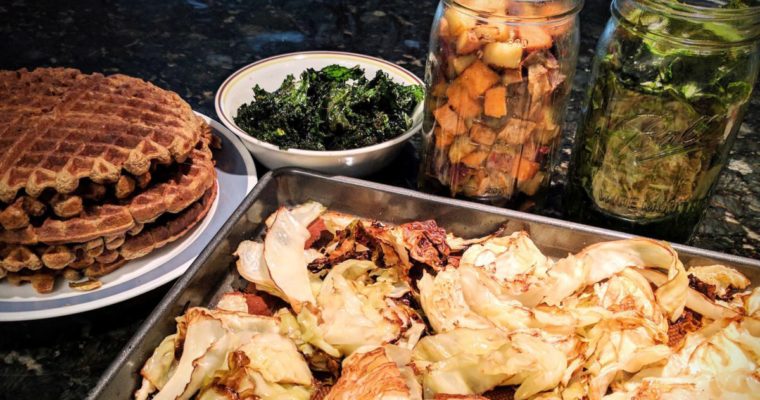Reintroductions on the AIP! They can strike terror into those of us who have found marked improvement of symptoms from autoimmune issues. We are afraid of going backward in our healing, but, the reintroduction process can also open up a world of foods for us to include in our diets. And we all know, variety is key for good gut health.
In this post I’ll briefly cover the when, why, what, and how to reintroduce foods after following the AIP. I’ll also share my own reintroduction process and the results.
If you’re not sure if the AIP is for you, see this post.
Why reintroduce foods.
When thinking about reintroductions on the AIP there are a few reasons you may want to dive into reintros. One reason is to build our confidence when it comes to what we put in our mouth! Going from being super-strict to knowing that a few random non-compliant ingredients won’t bother us can be a huge game-changer when going out to eat (if that’s ever a thing again) and when going to a friend’s house for dinner.
Another reason is to give our guts a greater diversity of nutrients. The more diverse our diets, the more our gut microbiome will be healthy and able to flourish.
We also can develop loss of oral tolerance over time – that is, if we keep our distance from certain foods our ability to tolerate those foods may go way down. Loss of oral tolerance can also be caused by hormones, stress, blood sugar issues, and other things. Dr. Datis Kharrazian explains oral tolerance very well in this article.
This all goes back to two things: Listening to your body, and digging down to address the things mentioned above (hormones, stress, blood sugar, etc) while on the AIP. As Dr. Kharraizan says: “The AIP diet was always meant as one of many functional medicine tools, not as a solitary approach to a complex health condition. If your health is not improving after removing inflammatory foods from your diet, that means you need to look for other factors.”
When to start reintroductions on the AIP.
When to do reintroductions on the AIP depends on how you are feeling, and if labs/tests show you are improving which will be highly dependant on your condition. For example, if you discover have SIBO (Small Intestinal Bacterial Overgrowth), you may want to further play around with your diet instead of jumping into reintroductions. If you have candida or parasite issues, same deal.
In short, when to reintroduce foods will be highly individual.
A minimum of 1 month on the AIP is suggested before reintroducing foods; 3 months is what most people do. Some stay on it for 6 months or longer. If you are eating a huge variety of nutrient-dense foods, which is the point of the diet part of the AIP, then loss of oral tolerance as mentioned above may not be as much of an issue, but, everyone will be different!
The whole point of the AIP is not just to eliminate foods, but to flood your body with nutrient-dense foods from a variety of sources. If you are eating only chicken, broccoli, and sweet potato for dinner every night, you need to expand your diet, stat! I played a game while I was following the AIP which was to try one new food or one new preparation of an old food every week. This “forced” me to buy different things every week – which did my gut good. It also was quite entertaining to learn how to cook cassava (which you can buy peeled and frozen, geez what a timesaver), how to prepare a beef heart (tip: save the fat aka tallow to use for skincare), and how to pressure cook an octopus and grill cactus leaves (the answer to both: very carefully).
If you are feeling pretty poorly it may take quite a while before you really see progress; that said, see note above about looking for other issues that may be causing your symptoms. The AIP is *not* a cure-all. Don’t assume it will solve all of your health issues, it rarely does. We usually have myriad issues going on at the same time, it’s your job to dig down and figure things out with the help of your doctor. Become a detective!
Eileen Laird of Phoenix Helix has a great post here that tracks various people’s time on the AIP. Her post also gives me a good excuse to remind everyone that the AIP is a protocol, not just a diet. Eileen writes:
“We also need to pay attention to that all-important lifestyle piece. While food is foremost in our mind, because we’re learning about food intolerance, lifestyle is equally important. Poor lifestyle choices can make our autoimmune disease flare just as fast as poor food choices. So get enough sleep every night, focus on reducing stress, incorporate joy and relaxation into your day, get outside in the fresh air and sunshine, try meditation or something similar, and find a way to exercise that supports your health. All of this is essential to healing, now and forever.”
What to reintroduce.
There are two schools of thought when it comes to reintroducing foods.
The first way starts with foods that are least likely to cause a reaction and has four stages (note: this is a partial list of each stage, a more comprehensive and detailed list can be found over at The Paleo Mom – here is her excellent post on reintroductions):
STAGE 1 REINTRODUCTIONS ON THE AIP
- egg yolks
- grass-fed ghee (clarified butter)
- seed oils and spices, nut oils, chocolate, coffee
- peas and green beans (and other legumes with edible pods)
STAGE 2 REINTRODUCTIONS
- egg whites
- seeds and nuts
- grass-fed butter
STAGE 3 REINTRODUCTIONS
- eggplants, peppers, potatoes
- grass-fed dairy
- legumes
STAGE 4 REINTRODUCTIONS
- tomatoes
- gluten-free grains
- white rice.
The second way to reintroduce foods is to start with a food you miss. After 2.5 months of strict AIP, I was missing eggs, so reintroduced egg yolks followed by egg whites. Then I played around with seeds, then nuts, and since it was summer, I jumped ahead to tomatoes (because summer).
I only recently reintroduced ghee (5 years after I did that initial elimination phase). More on my journey with reintros below.
How to do reintroductions on the AIP.
Whichever way you choose to start reintroducing foods, keep in mind that when you reintroduce a food, introduce only one food at a time. So this means no multi-ingredient processed or packaged foods. You don’t reintroduce hummus. You reintroduce chickpeas, tahini (sesame paste), and whatever other non-AIP ingredients are in the hummus – one food at a time.
When you try a food, the idea is to watch for reactions, and note if anything happens. Some use the 3-3-3 method to watch for reactions, which looks like this:
Have a bit of the food you have chosen to reintroduce. Wait 3 minutes for an “immediate” reaction (hives, gut distress, headache, etc).
If you are ok, have a few more bites and wait 3 hours.
If you are still ok, have a normal-sized portion and wait 3 days. Do not reintroduce any other foods during this time.
The story goes that “if you are ok by that 3rd day, you are fine with that food!” to which I say, well, maybe.
Maybe not.
It’s important to note that some reactions can be cumulative. I found this out when playing around with nut reintroductions. 3 days, nothing. So I started eating handfuls of nuts every day (I did not reintroduce anything else, I just enjoyed the heck out of those nuts). After 5 or 6 days of this behavior, I got symptomatic (for me this was my ears feeling clogged or “closed up”).
I did not even connect the dots between my ear issues and nuts until I went through this process with various nuts – it wasn’t until the third type of nut where a light-bulb went off – I had a handful of macadamia nuts and then 20 minutes later, ears closed up. I was so fascinated that I repeated this experiment many times over – and it always happened about 20 minutes after that fatal portion on the 5th or 6th day.
But: Here’s the deal. I eliminated nuts again for a few months and tried to reintroduce them again. This time, it took a full two weeks (!!) before my ears responded with their usual symptoms.
This told me that my gut was still healing and my body was getting “back on track”. Huzzah! It also boosted my confidence as I now knew for certain I could have these foods on occasion without any major issues – a boon when at a friend’s house or eating out.
My point in this story is: Be mindful of reactions taking a lot longer to show, and try not to get discouraged! Consider it all a grand experiment. Play around and see what works and what doesn’t, and remember that your reactions may be quite different (or nonexistent) a few months down the road. Keep a journal to track your progress.
Eileen Laird also has a great post on reintroductions on the AIP here.
Reintroductions on the AIP – what did I reintroduce?
I still feel my best when on strict AIP. But, as mentioned above, I wanted more diversity in my diet – and more confidence when eating outside of my own kitchen. So I chose to work hard on reintroductions with my diet.
Strict AIP is also a lot of work. If I am having a busy day and just don’t have time to cook, I know that rice and beans are ok for one night for me and I’m grateful to have these simple meals to fall back on once in a great while.
So what am I eating now? I know I’m “ok” with:
nuts, seeds, nightshades, legumes/beans/peas, white/brown rice, GF oats, corn, chocolate, eggs, ghee and some dairy.
Now that does NOT mean I don’t react at ALL to these foods. Nuts and seeds will close my ears up if I have too many of them. Nightshades make my joints super stiff if I overdo it. Chocolate just doesn’t like me, but I still like it, so. Too many beans/legumes are generally not great for me due to FODMAP issues, so I am mindful of taking it easy with those foods. Oats, rice and corn can be gluten cross-reactive (meaning they can act like gluten in the body) so I don’t have them often either. Same with dairy (dairy is a big no-no for those of us with Hashimoto’s, but, this Wisconsin girl has some cheese at the holidays and has made her peace with “cheating” once a year. I make sure I take lots of activated charcoal and drink tons of water after these cheats!)
In other words, I’ve made my peace with very minor reactions/symptoms and choose to deal with them occasionally. Many of these foods have great nutritional value; I like the idea of including them in my diet for this reason.
I’ve also made peace with foods I no longer eat, which include:
-
-
- gluten
- dairy (save for my once-a-year cheat, see above)
- industrial seed oils (corn, soy, vegetable, sunflower, safflower, rapeseed/canola, cottonseed, etc). These oils are highly processed and they do not do anyone’s body any favors. I avoid these oils before I avoid cheese and soy, that’s how adamant I am about keeping them out of my body! More on why these oils are bad in this post from Chris Kresser.
- soy (tofu, soy sauce, tempeh, edamame, etc) – soy can really mess with our hormones so I try to avoid it when at all possible.
-
Sometimes letting go of certain foods is hard. If you are not ready to let go, ask yourself: How is this food helping me? How is it harming me? How much longer am I willing to put up with symptoms before I’m ready to let go?
What are you choosing when it comes to the foods you eat – and the foods you avoid?
What are your thoughts on reintroducing foods on the AIP?
Are you excited about reintroducing? Scared?
What good might come if you try reintroducing? How might this help your health?
What will you do if you have a reaction to a food? (NOTE: It’s very important to anticipate challenges. Figure out now what you will do in the worst-case scenario. In other words, be prepared! Being prepared allows space to relax when reintroducing a food because you’ve already done the hard work of thinking through the “what ifs”.)
What foods will you NEVER reintroduce?
If you’re not yet ready to reintroduce, how will you know when you ARE ready?
My thoughts for you to ponder, shoot me an email if you want to share!
Until next time,
Sandy
MY OFFER TO YOU.
In light of all that’s been going on in this world, I would like to offer you, dear reader, some coaching.
I will listen deeply, offer empathy, and help you make sense of what’s going on in the world right now. It does not have to be about nutrition or autoimmune issues. We can talk about anything that’s on your mind.
We can talk about anything that’s on your mind:
- creating new habits in this “new normal” – or maintaining current habits
- work challenges – either working from home or being out of work
- figuring out how to best spend your time with your now at-home children (and still retain your sanity)
- how to cope if you have too much free time, or if you are finding it hard to strike a work-time vs. free-time balance in light of recent changes
- how best to manage stress
- guilty feelings about not having to go work or the gym or maybe cheating on your diet
- feeling ok doing absolutely nothing for a while
- helping you create structure in your life and a plan moving forward – whatever that may mean to you
- help you regain control if you are feeling out of control
- if you are a front-line worker, I can offer empathy and support for what you are facing right now.
To book your Complimentary “Meet & Greet” Session and Assessment, click here.
Be well, everyone, and I look forward to meeting you.
Sandy
Sandy Swanson is a Certified Functional Health Coach (A-CFHC) and a National Board Certified Health and Wellness Coach (NBC-HWC). You can learn more about her here and more about what coaching is here.
This page may contain affiliate links, which means I get a tiny percent of any products purchased from using the links on this page at no cost to you. This helps me keep my website running; I always appreciate it when these links are used!









